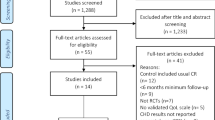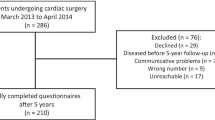Abstract
The aim of the present study was to assess change in health-related quality of life (HRQoL) after cardiac rehabilitation in the usual care setting, and to determine predictors for change. In the Post Infarction Care Study, 2441 patients were consecutively included at admission to 18 inpatient cardiac rehabilitation centres following coronary events. HRQoL was assessed with the SF-36 questionnaire at baseline as well as 6 and 12 months after discharge. HRQoL improved significantly in patients after coronary artery bypass grafting (CABG) but not in patients after myocardial infarction. Significant baseline predictors for change of the SF-36 physical component summary (PCS) score were the exercise ECG result at admission (0.59 absolute change/10-watt increase; 95% CI: 0.39, 0.79), an income ≥ 1750 € (1.64; 95% CI: 0.35, 2.93), baseline PCS score (−0.63; 95% CI: −0.69, −0.57), and CABG as indication for admission (3.65; 95% CI: 2.27, 5.04). Significant predictors for change of the mental component summary (MCS) score were age (1.28/10-year increase; 95% CI: 0.62, 1.94), East Germany as area of residence (2.62; 95% CI: 1.32, 3.91), baseline MCS score (−0.58; 95% CI: −0.63, −0.52), and CABG as indication for admission (1.68; 95% CI: 0.36, 3.01). The identification of predictors of HRQoL in the present study may aid in the further development and evaluation of cardiac rehabilitation programmes.
Similar content being viewed by others
References
Rosamond WD, Sembles LE, Fols Om AR, et al. Trends in the incidence of myocardial infarction and in mortality due to coronary heart disease, 1987–1994. N Engl J Med 1998; 339: 861-867.
Rumsfeld JS, Ma Whinney S, McCarthy M, et al. Health-related quality of life as a predictor of mortality following coronary artery bypass graft surgery. JAMA 1999; 281: 1298-1303.
Brown N, Melville M, Gray D, et al. Quality of life four years after acute myocardial infarction: Short form 36 scores compared with a normal population. Heart 1999; 81: 352-358.
Jette DU, Downing J. Health status of individuals entering a cardiac rehabilitation program as measured by the Medical Outcomes Study 36-Item Short-Form Survey (SF-36). Phys Ther 1994; 74: 521-527.
Covinsky KE, Chren MM, Harper DL, et al. Differences in patient-reported processes and outcomes between men and women with myocardial infarction. J Gen Intern Med 2000; 15: 169-174.
Krumholz HM, McHorney CA, Clark L, et al. Changes in health after elective percutaneous coronary revascularization. A comparison of generic and specific measures. Med Care 1996; 34: 754-759.
Bengtsson I, Hagman M, Wedel H. Age and angina as predictors of quality of life after myocardial infarction. Scand Cardiovasc J 2001; 35: 252-258.
Caine N, Sharples LD, Wallwork J. Prospective study of health related quality of life before and after coronary artery bypass grafting: Outcome at five years. Heart 1999; 81: 347-351.
Perski A, Feleke E, Anderson G, et al. Emotional distress before coronary bypass grafting limits the benefits of surgery. Am Heart J 1998; 136: 510-517.
Rawles J, Light J, Watt M. Quality of life in the first 100 days after suspected acute myocardial infarction-a suitable trial endpoint? J Epidemiol Commun Health 1992; 46: 612-616.
Mendes de Leon CF, Krumholz HM, Vaccarino V, et al. A population-based perspective of changes in health-related quality of life after myocardial infarction in older men and women. J Clin Epidemiol 1998; 51: 609-616.
Rumsfeld JS, Magid DJ, Plomondon ME, et al. Predictors of quality of life following acute coronary syndromes. Am J Cardiol 2001; 88: 781-784.
Pocock SJ, Henderson RA, Seed P, et al. Quality of life, employment status, and anginal symptoms after coronary angioplasty or bypass surgery. Circulation 1996; 94: 135-142.
Writing Group for the Bypass Angioplasty Revascularization Investigation (BARI) Investigators. Five-year clinical and functional outcome comparing bypass surgery and angioplasty in patients with multivessel coronary disease. A multicentre randomized trial. JAMA 1997; 277: 715-721.
Oldridge N, Guyatt G, Jones N, et al. Effects on quality of life with comprehensive rehabilitation after acute myocardial infarction. Am J Cardiol 1991; 67: 1084-1089.
McGee HM, Hevey D, Horgan JH. Psychosocial outcome assessments for use in cardiac rehabilitation service evaluation: A 10-year systematic review. Soc Sci Med 1999; 48: 1373-1393.
Dempster M, Donnelly M. Measuring the health related quality of life of people with ischaemic heart disease. Heart 2000; 83: 614-644.
Falcoz PE, Chocron S, Mercier M, et al. Comparison of the Nottingham Health Profile and the 36-Item Health Survey Questionnaires in cardiac surgery. Ann Thorac Surg 2002; 73: 1222-1228.
Lavie CJ, Milani RV. Effects of cardiac rehabilitation therapy programmes on exercise capacity, coronary risk factors, behavioral characteristics, and quality of life in a large elderly cohort. Am J Cardiol 1995; 76: 177-179.
Heller RF, Lim L, Valenti L, et al. Predictors for quality of life after hospital admission for heart attack or angina. Int J Cardiol 1997; 59: 161-166.
Herlitz J, Wiklund I, Caidahl K, et al. Determinants of an impaired quality of life five years after coronary artery bypass surgery. Heart 1999; 81: 342-346.
Willich SN, Müller-Nordhorn J, Kulig M, et al. Cardiac risk factors, medication, and recurrent clinical events after acute coronary disease — a prospective cohort study. Eur Heart J 2001; 22: 307-314.
Ware JE, Snow KK, Kosinski M, et al. SF-36 Health Survey. Manual and Interpretation Guide. Boston, MA: New England Medical Center, The Health Institute, 1993.
Ware JE, Kosinski M, Keller SD. SF-36 Physical and Mental Summary Scales: A User's Manual. Boston, MA: New England Medical Center, The Health Institute, 1994.
Bullinger M, Kirchberger I. Der SF-36 Fragebogen zum Gesundheitszustand. Handbuch für die deutschsprachige Fragebogenversion. Hogrefe Verlag für Psychologie. Göttingen Bern Toronto Seattle, 1998.
Kazis L, Anderson J, Meenan R. Effect sizes for interpreting changes in health status. Med Care 1989; 27: 178-189.
Wyrwich KW, Nienaber NA, Tierney WM, et al. Linking clinical relevance and statistical significance in evaluating intra-individual changes in health-related quality of life. Med Care 1999; 37: 469-478.
Guyatt G, Walter S, Norman G. Measuring change over time: Assessing the usefulness of evaluative instruments. J Chron Dis 1987; 40: 171-178.
Cohen J. Statistical power analysis for the behavioural sciences. Hillsdale, NJ: Lawrence Erlbaum Associates, 1988.
Lydick E, Epstein RS. Interpretation of quality of life changes. Qual Life Res 1993; 2: 221-226.
Michelson H, Bolund C, Nilsson B, et al. Health-related quality of life measured by the EORTC QLQ-C30 — reference values from a large sample of Swedish population. Acta Oncol 2000; 39: 477-484.
Penson DF, Stoddard ML, Pasta DJ, et al. The association between socioeconomic status, health insurance coverage, and quality of life in men with prostate cancer. J Clin Epidemiol 2001; 54: 350-358.
US Department of Health and Human Services. Cardiac rehabilitation. Clin prac guide 1995; 17: 1-202.
Jolliffe JA, Rees K, Taylor RS, et al. Exercise-based rehabilitation for coronary heart disease (Cochrane Review). In: The Cochrane Library, Issue 3. Oxford: Update Software, 2001.
Radoschewski M, Bellach BM. The SF-36 in the Federal Health Survey-possibilities and requirements for application at the population level. Gesundheitswesen 1999; 61: S191-S199.
McHorney CA, Kosinski M, Ware JE. Comparisons of the costs and quality of norms for the SF-36 health survey collected by mail versus telephone interview: Results from a national survey. Med Care 1994; 32: 551-567.
Mallinson S. The Short-Form 36 and older people: Some problems encountered when using postal administration. J Epidemiol Commun Health 1998; 52: 324-328.
Bjorner JB, Damsgaard MT, Watt T, et al. Tests of the data quality, scaling assumptions, and reliability of the Danish SF-36. J Clin Epidemiol 1998; 51: 1001-1011.
Hayes V, Morris J, Wolfe C, et al. The SF-36 health survey questionnaire: Is it suitable for use with older adults? Age Ageing 1995; 24: 120-125.
Loge JH, Kaasa S, Hjermstad MJ, et al. Translation and performance of the Norwegian SF-36 Health Survey in patients with rheumatoid arthritis. I. Data quality, scaling assumptions, reliability, and construct validity. J Clin Epidemiol 1998; 51: 1069-1076.
Author information
Authors and Affiliations
Rights and permissions
About this article
Cite this article
Müller-Nordhorn, J., Kulig, M., Binting, S. et al. Change in quality of life in the year following cardiac rehabilitation. Qual Life Res 13, 399–410 (2004). https://doi.org/10.1023/B:QURE.0000018473.55508.6a
Issue Date:
DOI: https://doi.org/10.1023/B:QURE.0000018473.55508.6a




